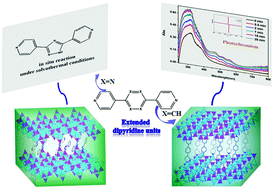Zinc-diphosphonates with extended dipyridine units: synthesis, structures, in situ reactions, and photochromism†
Abstract
Two zinc-diphosphonates formed from extended dipyridine units di-3,6-(4′-pyridyl)-1,2,4,5-tetrazine (dipytz) and 1,4-di(pyridine-4-yl)benzene (pbyb), [H2-Hdpt][Zn3(HEDP)2(H2O)]·2H2O (1) and [Zn2(HEDP)(pbyb)0.5(H2O)]·H2O (2) were solvothermally prepared (HEDP = 1-hydroxyethylidenediphosphonate, Hdpt = 1H-3,5-bis(4-pyridyl)-1,2,4-triazole). Compound 1 exhibits an anionic Zn-HEDP layer with protonated dipyridine fragments as the template. In 2, the HEDP ligands bridge Zn2+ ions to form neutral zincophosphonate layers as supramolecular building blocks (SBBs), which are further pillared by neutral pbyb moieties to generate the final 3D pillar-layer structure. Interestingly, in situ reactions have taken place in the formation of 1, and the starting material dipytz in situ transformed to Hdpt in the process of assembly and was captured in the resultant crystal. Although the structural constituents are non-photochromic, 2 features photochromic performance with a detectable color change from colorless to pink under the stimulus of UV light under ambient conditions. A reversible color change process has been realized via annealing the colored sample at 120 °C for half an hour or putting the colored sample in air for two hours.



 Please wait while we load your content...
Please wait while we load your content...